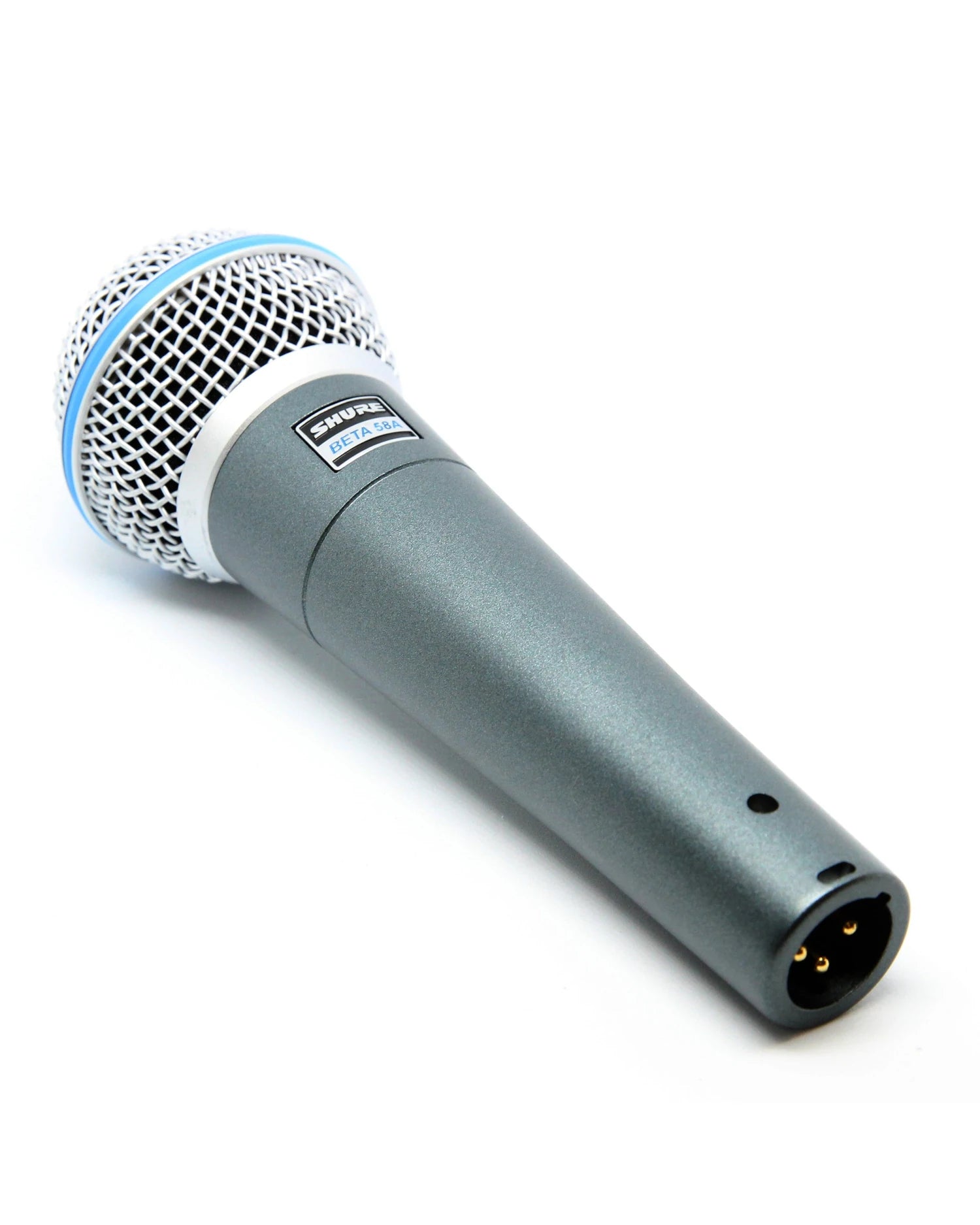Description
Big sound. Full sound. Sophisticated sound. Is your mic living up to the power of your vocal? For decades, the BETA® 58A has been through the wringer, pushing voice to the forefront on the biggest stages in the world. For sound that commands the attention of the entire crowd, this is your microphone.
- 1 - A25D Adjustable Stand Adapter
- 1 - 95A2050 5/8” to 3/8” (Euro) Thread Adapter
- 1 - 26A21 Storage Bag
General Description
The Shure BETA58®A dynamic microphone is precision-engineered for vocals in professional live sound reinforcement and studio recording applications. A tailored frequency response accentuates the clarity of vocals, and a tight, supercardioid pickup pattern ensures high gain before feedback, maximum sound isolation, and minimum off-axis tone coloration.
The BETA58A is ideal for close-up lead and background vocals, especially in high sound pressure level (SPL) environments. A proven shock mount system, hardened steel-mesh grille, and superior build quality withstand the rigors of daily sound reinforcement.
Features
- Premier live performance microphone with Shure quality, ruggedness, and reliability
- Uniform supercardioid pick-up pattern for maximum gain before feedback and superior rejection of off-axis sound
- Tailored frequency response specifically shaped for vocals, with brightened midrange and bass roll off to control proximity effect
- Neodymium magnet for greater sensitivity and higher output
- Advanced pneumatic shock mount system that minimizes transmission of mechanical noise and vibration
- Dent-resistant steel mesh grille and enamel coated die-cast metal construction resist wear and abuse
- Effective built-in pop filter reduces undesirable wind and breath noise
General Rules for Use
- Do not cover any part of the microphone grille with your hand, as this will adversely affect microphone performance.
- Aim the microphone toward the desired sound source (such as the talker, singer, or instrument) and away from unwanted sources.
- Place the microphone as close as practical to the desired sound source.
- Work close to the microphone for extra bass response.
- Use only one microphone to pick up a single sound source.
- For better gain before feedback, use fewer microphones.
- Keep the distance between microphones at least three times the distance from each microphone to its source (“three to one rule”).
- Place microphones as far as possible from reflective surfaces.
- Add a windscreen when using the microphone outdoors.
- Avoid excessive handling to minimize pickup of mechanical noise and vibration.
Applications And Placement
The following table lists the most common applications and placement techniques. Keep in mind that microphone technique is largely a matter of personal taste; there is no one “correct” microphone position.
| Application | Suggested Microphone Placement | Tone Quality |
|---|---|---|
| Vocals | Lips less than 15 cm (6 in.) away or touching the windscreen, on axis to microphone. | Robust sound, emphasized bass, maximum isolation from other sources. |
| 15 to 60 cm (6 in. to 2 ft.) away from mouth, just above nose height. | Natural sound, reduced bass. | |
| 20 to 60 cm (8 in. to 2 ft.) away from mouth, slightly off to one side. | Natural sound, reduced bass and minimal “s” sounds. | |
| 90 cm to 1.8 m (3 to 6 ft.) away. | Thinner, distant sound; noticeable levels of ambient noise. | |
| Guitar & Bass Amplifiers | 2.5 cm (1 in.) from speaker, on-axis with center of speaker cone.` | Sharp attack; emphasized bass. |
| 2.5 cm (1 in.) from speaker, at edge of speaker cone. | Sharp attack; higher frequency sound. | |
| 15 to 30 cm (6 to 12 in.) away from speaker and on-axis with speaker cone. | Medium attack; full, balanced sound. | |
| 60 to 90 cm (2 to 3 ft.) back from speaker, on-axis with speaker cone. | Softer attack; reduced bass. |
Avoiding Pickup of Unwanted Sound Sources
A supercardioid microphone has the greatest sound rejection at points 120° toward the rear of the microphone. Place the microphone so that unwanted sound sources, such as monitors and loudspeakers, are at these angles, not directly behind it. To minimize feedback and ensure optimum rejection of unwanted sound, always test microphone placement before a performance.

Recommended Loudspeaker Locations for Supercardioid Microphones
Proximity Effect
Unidirectional (cardioid) microphones progressively boost bass frequencies by 6 to 10 dB below 100 Hz when the microphone is at a distance of about 6 mm (1/4 in.) from the sound source. This phenomenon, known as proximity effect, can be used to create a warmer, more powerful sound. To prevent explosive low frequency sound during close-up use, the bass response gradually rolls off. This provides greater control and helps the user take advantage of proximity effect.
Specifications
Type
Dynamic (moving coil)
Frequency Response
50 to 16,000 Hz
Polar Pattern
Supercardioid
Output Impedance
EIA rated at 150 Ω (290 Ω actual)
Sensitivity
at 1kHz, open circuit voltage
-51.5 dBV/Pa (2 .6 mV)[1]
Polarity
Positive pressure on diaphragm produces positive voltage on pin 2 with respect to pin 3
Weight
Net
0.278 kg (0.62 lbs)
Connector
Three-pin professional audio (XLR), male, balanced
Housing
Silver blue enamel-painted die cast metal with hardened, matte-finished steel mesh grille
[1] 1 Pa=94 dB SPL

Overall Dimensions

Typical Frequency Response

Typical Polar Patterns

Wiring Diagram






